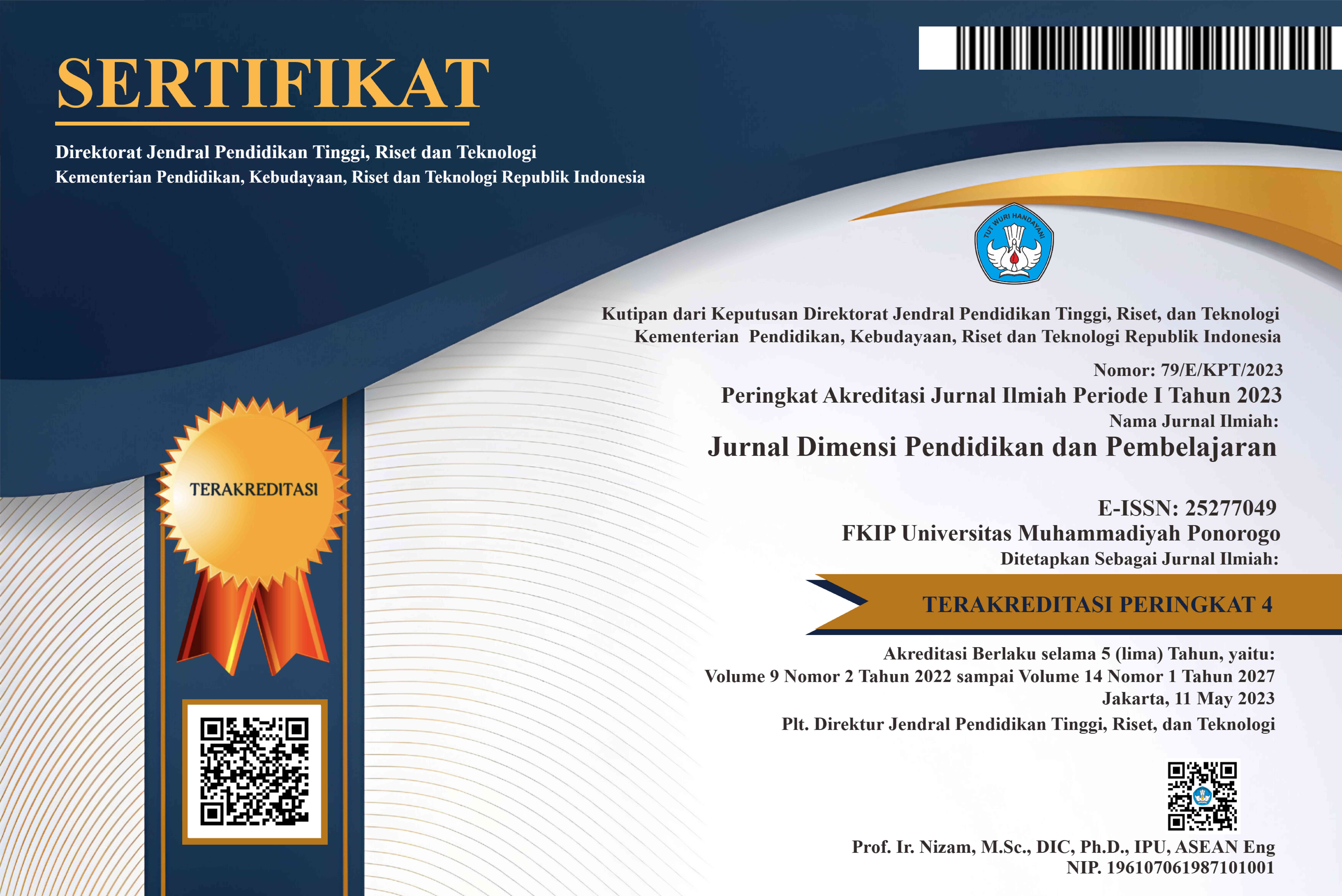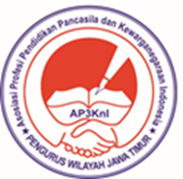Penggunaan Media Audio Visual Berbasis Powtoon Untuk Meningkatkan Kemampuan Representasi IPA Di Tengah Pandemi Covid 19
DOI:
https://doi.org/10.24269/dpp.v9i2.3607Abstract
Representasi IPA merupakan salah satu kemampuan yang harus dikembangan pada pembelajaran abad 21. Terutama pada materi sistem pernapasan manusia yang cenderung abstrak dalam pembahasannya. Berdasarkan hasil observasi ditemukan nilai kemampuan representasi  63,61 yang artinya dalam kategori rendah. Penggunaan media audio visual berbasis powtoon diharapkan mampu memudahkan dan meningkatkan kemampuan representasi peserta didik. Penelitian ini bertujuan untuk mengetahui efektifitas media dalam meningkatkan kemampuan representasi. Metode penelitian menggunakan model RnD. Tahapan mengembangkan media 1) studi pendahuluan, 2) tahapan pengembangan, dan 3) pengujian produk. Pengambilan sampel menggunakan teknik random sampling dan claster random sampling. Data dikumpulkan menggunakan tes dan angket. Kemudian dianalisis secara deskriptif kualitatif, kuantitatif dengan N-Gain, dan statistik inferensi uji-t. Berdasarkan hasil penelitian ditemukan: keefektifan media dapat meningkatkan kemampuan representasi melalui uji n-gain klasikal yaitu kelas eksperimen 61,38% > kelas kontrol 48,20%. Uji-t two tailed terdapat perbedaan antara kelas yang menggunakan media powtoon dengan kelas yang tidak (α=0,05) hasil uji-t one-tailed thitung -2,564 < -1,697 terdapat peningkatan yang signifikan pada kelas eksperimen.
Â
Abstract
The representation of science is one of the abilities that must be developed in 21th century learning. Especially in the material of the human respiratory system which tends to be abstract in its discussion. Based on the results of observations found the value of the ability of representation 63.61 it means in the low category. The use of powtoon-based audio visual media is expected to simplify and improve the representation ability of students. This research aims to know the effectiveness of the media in improving the ability of representation. The method uses the RnD model. Stages of developing media 1) preliminary studies, 2) stages of development, and 3) product testing. Sampling using random sampling techniques and cluster random sampling. Data collected using tests and questionnaires. Analyzed descriptively qualitative, quantitative with N-Gain, and t-test inference statistics. Based on the results of the study found: the effectiveness of media can improve the ability representation through the classical n-gain test is the experimental class 61.38% > 48.20% control class. Two tailed t-test there is a difference between the class using the media powtoon with a class that does not (α = 0.05) the results of the one-tailed t-test -2,564 <-1,697, there is a significant increase in the experimental class.
Â
References
Arcavi, A. (2003). The role of visual representations in the learning of mathematics. Educational Studies in Mathematics, 52(3), 215–241.
Astika, R. Y., Anggoro, B. S., & Andriani, S. (2019). Pengembangan video media pembelajaran matematika dengan bantuan powtoon. Jurnal Pemikiran Dan Penelitian Pendidikan Matematika (JP3M), 2(2), 85–96.
Chandra, F. H., & Nugroho, Y. W. (n.d.). Teknologi Dan Pedagogy: Video Tutorial Dalam Metode Pembelajaran Flipped Classroom. Prosiding Seminar Nasional Teknologi Pendidikan 2015, 307.
De Bello, T. C. (1990). Comparison of eleven major learning styles models: Variables, appropriate populations, validity of instrumentation, and the research behind them. Reading, Writing, and Learning Disabilities, 6(3), 203–222.
Dickey, M. D. (2003). Teaching in 3D: Pedagogical affordances and constraints of 3D virtual worlds for synchronous distance learning. Distance Education, 24(1), 105–121.
Duffy, P. (2008). Engaging the YouTube Google-eyed generation: Strategies for using Web 2.0 in teaching and learning. Electronic Journal of E-Learning, 6(2), 119–130.
Edelson, D. C. (2001). Learning-for-use: A framework for the design of technology-supported inquiry activities. Journal of Research in Science Teaching, 38(3), 355–385.
Effendi, L. A. (2012). Pembelajaran matematika dengan metode penemuan terbimbing untuk meningkatkan kemampuan representasi dan pemecahan masalah matematis siswa SMP. Jurnal Penelitian Pendidikan, 13(2), 1–10.
Fajar, S. (2017). Pengaruh Penggunaan Media Powtoon Terhadap Hasil Belajar Siswa Pada Mata Pelajaran Ilmu Pengetahuan Sosial Terpadu: Kuasi Eksperimen Terhadap Siswa Kelas VII SMPN 25 Kota Bandung [PhD Thesis]. Universitas Pendidikan Indonesia.
Fakhry, J. (2010). Sains dan Teknologi dalam al-Qur’an dan Implikasinya dalam Pembelajaran. Ta’dib: Journal of Islamic Education (Jurnal Pendidikan Islam), 15(01), 121–142.
Hurley, J. M., Proctor, J. D., & Ford, R. E. (1999). Collaborative inquiry at a distance: Using the Internet in geography education. Journal of Geography, 98(3), 128–140.
Indonesia, P. R. (2003). Undang-undang Republik Indonesia nomor 20 tahun 2003 tentang sistem pendidikan nasional. Jakarta: Pemerintah Republik Indonesia.
Karatza, Z. (2019). Information and communication technology (ICT) as a tool of differentiated instruction: An informative intervention and a comparative study on educators’ views and extent of ICT use. International Journal of Information and Education Technology, 9(1), 8–15.
Keengwe, J., Onchwari, G., & Wachira, P. (2008). Computer technology integration and student learning: Barriers and promise. Journal of Science Education and Technology, 17(6), 560–565.
Lestari, I. D., Yuliati, L., & Suwono, H. (2018). Kemampuan Representasi Siswa SMP dalam The 5E Learning Cycle dengan Reflective Self Assessment pada Materi Kalor. Jurnal Pendidikan: Teori, Penelitian, Dan Pengembangan, 3(2), 165–173.
Maryani, E., & Syamsudin, H. (2009). Pengembangan Program Pembelajaran IPS untuk meningkatkan kompetensi Keterampilan sosial. Jurnal Penelitian, 9(1).
Mayer, R. E. (2003). The promise of multimedia learning: Using the same instructional design methods across different media. Learning and Instruction, 13(2), 125–139.
Megawati, N. M. S., & IGALP, U. (2020). English Learning with Powtoon Animation Video. Journal of Education Technology, 4(2), 110–119.
Permendiknas, R. I. (2017). No. 16 Tahun 2007 tentang Standar Kualifikasi Akademik dan Kompetensi Guru. Jakarta: Depdiknas.
Rayner, S., & Riding, R. (1997). Towards a categorisation of cognitive styles and learning styles. Educational Psychology, 17(1–2), 5–27.
Riding, R., & Rayner, S. (2013). Cognitive styles and learning strategies: Understanding style differences in learning and behavior. Routledge.
salim Nahdi, D. (2017). Implementasi model pembelajaran collaborative problem solving Untuk meningkatkan kemampuan representasi matematis siswa sekolah dasar. Jurnal Cakrawala Pendas, 3(1).
Setyarini, S. (2010). Puppet Showâ€: Inovasi metode pengajaran bahasa inggris dalam upaya meningkatkan kemampuan berbicara siswa SD. Jurnal Penelitian Pendidikan, 11(1), 1–6.
Simonson, M., Schlosser, C., & Orellana, A. (2011). Distance education research: A review of the literature. Journal of Computing in Higher Education, 23(2–3), 124.
Simonson, M., Zvacek, S. M., & Smaldino, S. (2019). Teaching and Learning at a Distance: Foundations of Distance Education 7th Edition. IAP.
Sugiyono. (2015). Metode Penelitian & Pengembangan: Research and Development. Alfabeta.
Sulistyowaty, R. K., Kesumah, Y. S., & Priatna, B. A. (2019). Peningkatan Kemampuan Representasi Matematis Melalui Pembelajaran Collaborative Problem Solving. Jurnal Pendidikan Matematika, 13(2), 153–162.
Taradi, S. K., Taradi, M., Radić, K., & Pokrajac, N. (2005). Blending problem-based learning with Web technology positively impacts student learning outcomes in acid-base physiology. Advances in Physiology Education.
Wulandari, D. A. (2016). Pengembangan Media Pembelajaran Menggunakan Sparkol Videoscribe dalam Meningkatkan Minat Belajar Siswa pada Mata Pelajaran IPA Materi Cahaya Kelas VIII di SMP Negeri 01 Kerjo Tahun Ajaran 2015/2016 [PhD Thesis]. Universitas Negeri Semarang.
Downloads
Published
Issue
Section
License
Copyright
Authors who publish their manuscripts in this journal agree to the following terms:
- The copyright on each article belongs to the author.
- The author acknowledges that Jurnal Dimensi Pendidikan dan Pembelajaran has the right to be the first to publish under a Creative Commons Attribution 4.0 International (Attribution 4.0 International CC BY 4.0) license.
- Authors may submit articles separately, arranging for the non-exclusive distribution of manuscripts that have been published in this journal to other versions (e.g., sent to the author's institutional repository, publication into books, etc.), acknowledging that the manuscript was first published in the Jurnal Dimensi Pendidikan dan Pembelajaran.
Â
License
Use of the article will be governed by the Creative Commons Attribution license as currently published under the Creative Commons Attribution 4.0 International License (Attribution 4.0 International (CC BY 4.0).
Â
This license permits anyone to copy and redistribute this material in any form or format, compose, modify, and make derivatives of this material for any purpose, including commercial purposes, as long as they give credit to the author for the original work.



_001.jpg)



